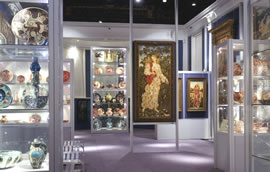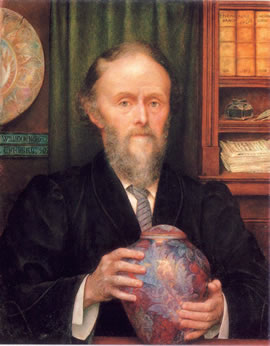Last Chance to See - The De Morgan Centre
Local museum to shut its doors to public later this month
The De Morgan Centre houses a rare collection of work by William De Morgan, the most important ceramicist of the Arts and Crafts Movement and the pre-Raphaelite paintings of his wife, Evelyn. William and Evelyn De Morgan were part of a fascinating Victorian arts scene that involved the great thinkers and artists of the age, including William Morris, Edward Burne-Jones and Dante Gabriel Rossetti.
The De Morgan Foundation opened the Centre to the public in 2002; however the local authority’s decision to terminate the charity’s lease as part of a cost cutting drive means that the Centre has to close. In February 2007, Wandsworth Borough Council made the unpopular decision to close Wandsworth Museum and two local libraries due to a reduction in central government funding. The De Morgan Centre which is based in one of the affected libraries was also given notice to leave. The trustees of the Foundation are in the process of identifying a suitable new home.
The last chance to view the collection will be the 25th July 2009. After this date it will be closed to allow for essential conservation work to take place on both the paintings and ceramics prior to moving and to prepare for an exciting opportunity to tour highlights of the collection (dates and venues to be announced). However, the Centre will still be available to view until mid-Autumn for group visits and research purposes by appointment only.
The final temporary exhibition at the De Morgan Centre is a fitting tribute to Jon Catleugh, who dedicated his life to De Morgan. Jon Denis Harwood Catleugh had many facets to his life – soldier, architect, designer, painter, collector and ceramic historian.
Jon Catleugh was born in 1920 in King’s Lynn, Norfolk. He was educated at Oundle School and in 1939 entered the Bartlett school of architecture, London. His studies were interrupted by the war, and he enlisted in the Army. He took part in the D-Day landings, by then a captain. On June 11, in the assault on Caen, he was seriously wounded and invalided home. After a long convalescence he was able to continue his studies and qualified as an architect in 1949.
In the 1950s Catleugh was very active in the arts and was described as part of the 1950’s ‘Tachiste Tornado’ by Herbert Reed. An exhibition of Jackson Pollock’s work in Venice (1949), proved to be a pivotal moment and he became fascinated by the endless possibilities of the ‘drip and pour’ technique. Working straight from tins of paint, his complex works were controlled and rhythmic. By 1953, Catleugh became associated with the constructivist revival in Britain, working on a series of paper collages which were described by Oswell Blakeston in Art News and Review, as having the effect of ‘looking through slats at a confetti world’. He was represented by the avant-garde Gimpel Fils Gallery and had two solo exhibitions there in 1953 and 1954. In 1956 he took part in the seminal This is Tomorrow exhibition at the Whitechapel Gallery, a multidisciplinary collaboration of architects, artists, musicians and graphic designers.
In 1988 Catleugh took part in a two man show retrospective exhibition: Reflections of the Fifties at the England and Co. Gallery (Notting Hill). The show was successful not only in reinvigorating the public’s interest in his earlier work, but in inspiring Catleugh to once again pick up his brushes. The body of paintings shown in this current exhibition were the results of his renewed passion for painting in the early 1990s.
Catleugh bough his first William De Morgan tile in 1949 and this was to be the beginning of a life long obsession, leading him to become the foremost expert on De Morgan and his tiles. He was invited by the Trustees of the De Morgan Foundation in 1971 to look after the Foundation’s ceramic interests, a role which he took very seriously. He became Chairman of the Charity in 1995 and under his stewardship the Foundation set up the critically acclaimed museum the De Morgan Centre which opened to the public in 2002. During this year he retired as Chairman and became Honorary Life President of the Foundation. He remained active as a board member and advisor until his death in January 2009.
The exhibition displays 38 paintings completed by Catleugh in the early 1990’s and they will be sold by auction at the Centre on the 24th July 2009. The proceeds of the auction of will go towards establishing the planned new home for the De Morgan Foundation collection.
Claire Longworth
Curator
The De Morgan Centre
July 14, 2009
Related links
|

